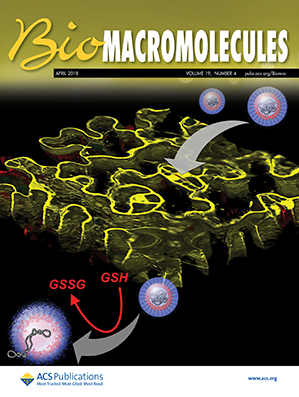Single-Step Synthesis of Highly Sensitive 19F MRI Tracers by Gradient Copolymerization-Induced Self-Assembly
IF 5.5
2区 化学
Q1 BIOCHEMISTRY & MOLECULAR BIOLOGY
引用次数: 0
Abstract
Amphiphilic gradient copolymers are promising alternatives to block copolymers for self-assembled nanomaterials due to their straightforward synthesis via statistical copolymerization of monomers with different reactivities and hydrophilicity. By carefully selecting monomers, nanoparticles can be synthesized in a single step through gradient copolymerization-induced self-assembly (gPISA). We synthesized highly sensitive 19F MRI nanotracers via aqueous dispersion gPISA of hydrophilic poly(ethylene glycol) methyl ether methacrylate (PEGMA) with core-forming N,N-(2,2,2-trifluoroethyl)acrylamide (TFEAM). The PPEGMA-grad-PTFEAM nanoparticles were optimized to achieve spherical morphology and exceptional 19F MRI performance. Noncytotoxicity was confirmed in Panc-1 cells. In vitro 19F MR relaxometry and imaging demonstrated their diagnostic imaging potential. Notably, these gradient copolymer nanotracers outperformed block copolymer analogs in 19F MRI performance due to their gradient architecture, enhancing 19F relaxivity. The synthetic versatility and superior 19F MRI performance of gradient copolymers highlight their potential in advanced diagnostic imaging applications.
- Download: Download high-res image (96KB)
- Download: Download full-size image
通过梯度共聚诱导自组装一步合成高灵敏度 19F MRI 示踪剂。
两亲梯度共聚物是嵌段共聚物的理想替代品,可用于自组装纳米材料,因为它们可以通过具有不同反应活性和亲水性的单体的统计共聚直接合成。通过精心选择单体,可通过梯度共聚诱导自组装(gPISA)一步合成纳米粒子。我们通过亲水性聚(乙二醇)甲基醚甲基丙烯酸酯(PEGMA)与成芯的 N,N-(2,2,2-三氟乙基)丙烯酰胺(TFEAM)的水分散 gPISA 合成了高灵敏度的 19F MRI 纳米曳光弹。对 PPEGMA-grad-PTFEAM 纳米粒子进行了优化,以获得球形形态和优异的 19F MRI 性能。在 Panc-1 细胞中证实了其无细胞毒性。体外 19F 磁共振弛豫测量和成像证明了它们在诊断成像方面的潜力。值得注意的是,这些梯度共聚物纳米曳光弹的 19F MRI 性能优于嵌段共聚物类似物,这是因为它们的梯度结构提高了 19F 的弛豫性。梯度共聚物的合成多样性和卓越的 19F MRI 性能凸显了它们在先进诊断成像应用中的潜力。
本文章由计算机程序翻译,如有差异,请以英文原文为准。
求助全文
约1分钟内获得全文
求助全文
来源期刊

Biomacromolecules
化学-高分子科学
CiteScore
10.60
自引率
4.80%
发文量
417
审稿时长
1.6 months
期刊介绍:
Biomacromolecules is a leading forum for the dissemination of cutting-edge research at the interface of polymer science and biology. Submissions to Biomacromolecules should contain strong elements of innovation in terms of macromolecular design, synthesis and characterization, or in the application of polymer materials to biology and medicine.
Topics covered by Biomacromolecules include, but are not exclusively limited to: sustainable polymers, polymers based on natural and renewable resources, degradable polymers, polymer conjugates, polymeric drugs, polymers in biocatalysis, biomacromolecular assembly, biomimetic polymers, polymer-biomineral hybrids, biomimetic-polymer processing, polymer recycling, bioactive polymer surfaces, original polymer design for biomedical applications such as immunotherapy, drug delivery, gene delivery, antimicrobial applications, diagnostic imaging and biosensing, polymers in tissue engineering and regenerative medicine, polymeric scaffolds and hydrogels for cell culture and delivery.
 求助内容:
求助内容: 应助结果提醒方式:
应助结果提醒方式:


